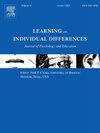感知目标结构与学生成绩:课堂内外动机体验的一致性
IF 3.8
1区 心理学
Q1 PSYCHOLOGY, EDUCATIONAL
引用次数: 0
摘要
我们的研究调查了动机体验在课堂之间和课堂内部是否一致,重点关注学生对目标结构、个人成就目标和成绩的看法。我们使用多层结构方程模型对1268名九年级学生(51.7%为女生;平均年龄14.87岁;标准偏差= 0.39)分为72类。我们的研究结果表明,不同班级的学生对目标结构的感知存在差异,共同的掌握目标感知与课堂平均成绩呈正相关。在课堂上,当个别学生感受到更多与掌握相关的信息时,他们的个人成就目标(掌握和表现)就会更高。然而,在两种学生成就目标取向中,只有掌握目标与成绩呈正相关,并在掌握目标结构与成绩之间起中介作用。此外,来自较不富裕家庭的学生在两种目标导向上的得分都较低,在学习环境中观察到的绩效导向信息也较少;男孩的掌握倾向较低。成就目标部分解释了学生背景对成绩的影响,这表明不平等的动机经历可能部分解释了与社会不平等相关的成就差距。本文章由计算机程序翻译,如有差异,请以英文原文为准。
Perceived goal structures and student outcomes: Consistency of motivational experiences within and across classrooms
Our study investigates whether motivation experiences are consistent between and within classrooms, focusing on students' perceptions of goal structures, personal achievement goals, and grades. We used multilevel structural equation modeling with data collected from 1268 ninth-grade students (51.7 % females; average age = 14.87; standard deviation = 0.39) placed in 72 classes. Our findings show that students' perceptions of goal structures vary across classrooms, and that shared mastery goal perceptions are positively associated with average classroom grades. Within classrooms, when individual students perceive more mastery-related messages, their personal achievement goals (both mastery and performance) are higher. However, only mastery goals, out of the two student achievement goal orientations, are positively linked with grades and mediate between mastery goal structures and grades. Moreover, students from less affluent families have lower scores on both goal orientations and observe fewer performance-oriented messages in their learning environment; boys report lower mastery orientation. Student background effects on grades are partly explained by achievement goals, suggesting that unequal motivational experiences may partly account for achievement gaps related to social inequalities.
求助全文
通过发布文献求助,成功后即可免费获取论文全文。
去求助
来源期刊

Learning and Individual Differences
PSYCHOLOGY, EDUCATIONAL-
CiteScore
6.60
自引率
2.80%
发文量
86
期刊介绍:
Learning and Individual Differences is a research journal devoted to publishing articles of individual differences as they relate to learning within an educational context. The Journal focuses on original empirical studies of high theoretical and methodological rigor that that make a substantial scientific contribution. Learning and Individual Differences publishes original research. Manuscripts should be no longer than 7500 words of primary text (not including tables, figures, references).
 求助内容:
求助内容: 应助结果提醒方式:
应助结果提醒方式:


